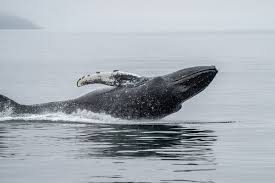Study delves into increase in humpback whale sightings in UK and Ireland

London: Earlier this year, U.K. media reported an increase in humpback whale sightings in British and Irish waters.
Between December 2024 and January, The Guardian reported some 17 sightings of humpback whales (Megaptera novaeangliae) from the Isles of Scilly in southwest England. Meanwhile, the nonprofit Sussex Dolphin Project reported more than 50 sightings from Sussex in southeast England during the 2024-2025 winter season.
Thea Taylor, managing director at the Sussex Dolphin Project, told the BBC they’re not entirely certain where the whales are coming, but they “believe the humpbacks that pass through the Eastern English Channel are coming from the feeding grounds in the Arctic Circle and travelling South to warmer waters often used for breeding grounds.”
“They would usually travel along the West Coast of the UK, and we do not currently know what causes them to travel down the East Coast,” Taylor said.
Marine biologist Gemma Halstead with the University of Exeter told Mongabay by email: “I believe there’s enough evidence to show that humpback whale visits to the UK and Ireland have increased over the past 20 years.”
A 2019 study reported increased sightings of humpback whales in Scotland during the winters of 2017 and 2018.
Many humpback populations appear to be recovering after a ban on commercial whaling in 1986. But one reason for the recent increase in sightings along the U.K. coasts could be prey availability, Halstead said: “Where the fish go, the whales tend to follow.”
“Humpback whales feed on small schooling fish, which are commonly found along UK and Irish coastlines,” Halstead added. “These waters also offer ideal habitat conditions, especially around the continental shelf edges. We’re also positioned along the natural migration route that humpbacks use to travel between their breeding and feeding grounds, making these waters a convenient stopover.”
Additionally, there’s growing public awareness about the whales, and better ways to report sightings. “This is something we’re mindful of when interpreting the data,” she added.
Halstead said it’s “especially encouraging” to see the increase in humpback observations from those who regularly spend time on the water. “Marine wildlife tour guides, researchers, and other regular seafarers have shared that they are encountering humpbacks more often in their regions. Their local knowledge provides vital context and helps strengthen the patterns we’re seeing in the reported sightings data,” she said.
Halstead is leading a research project with the University of Exeter to understand the presence of humpback whales in U.K. and Irish waters by combining sightings data from the public, wildlife enthusiasts and organizations. “As awareness and sightings grow, so does our opportunity to learn,” she said.
Halstead said that by reporting sightings, through platforms like HappyWhale, people “can contribute valuable data that helps build a clearer picture of this wonderful species’ movements and presence around the UK and Ireland.”





